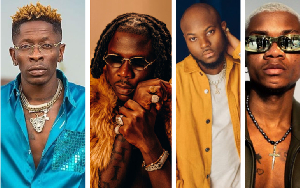 Shatta Wale, Stonebwoy, King Promise and KiDi
Shatta Wale, Stonebwoy, King Promise and KiDi
Music, with its diverse forms and interpretations, remains a powerful medium of harmony, expression, and emotion. In Ghana, the evolution of music is a testament to the country’s rich cultural tapestry and the artists who have shaped its soundscape.
Ghanaian music is a melting pot of influences, driven by the country’s unique geographical and cultural context. From the early days of traditional highlife to the contemporary sounds of Afrobeat and hiplife, the nation’s music has continually adapted and evolved, creating a fusion of genres that resonates both locally and internationally.
As Ghana’s first president, Dr. Kwame Nkrumah, once said, “We live in a world of contradictions, but these contradictions, however, keep the world going.” This sentiment echoes in the Ghanaian music industry, where contrasts and controversies often drive its dynamism and commercial success.
The journey of hiplife, for example, cannot be discussed without acknowledging the pioneers who laid its foundation. From Gyedu-Blay Ambolley’s early ‘Simigwa’ style to Reggie Rockstone’s groundbreaking ‘Agoo,’ which introduced hiplife to the masses, the genre has become a cornerstone of Ghanaian music.
The evolution continued with artists like Nana King, whose introduction of Ex-Doe’s ‘Maba’ sparked a rivalry with Chicago that forever altered the landscape of Ghanaian music, drawing parallels to the famous East Coast-West Coast feud between Tupac Shakur and Biggie Smalls in the United States.
Music is not just an art form but a business, a fact underscored by Charles Nii Armah Mensah, better known as Shatta Wale. His collaboration with Beyoncé on the track ‘Already’ highlighted the lucrative potential of Ghanaian music on the global stage, showcasing the industry’s commercial viability.
The music of Ghana’s past, characterized by legends like Daddy Lumba, Bibie Brew, Ebo Taylor, and George Darko, laid the foundation for today’s highlife artists such as Kwabena Kwabena, Akwaboa, and K. Dei. Similarly, the influence of Fela Anikulapo Kuti, who once resided in Kumasi to learn traditional highlife, is evident in his transformation of the genre into Afrobeat—a style that has taken the world by storm.
Ghana’s musical heritage has also inspired Congolese legends like Papa Wemba and Koffi Olomide, who have drawn from the rhythms and melodies of this small West African nation. The rise of hiplife, a fusion of rap and highlife, further illustrates the adaptability and enduring appeal of Ghanaian music.
While debates over who truly introduced hiplife persist, the genre’s impact on the music industry is undeniable. Artists like Lord Kenya, Tic Tac, Terry Bon Chaka, Mensa, Sly Lover, Samini, and others have all contributed to its rich history.
In discussing contemporary Ghanaian music, it is impossible to overlook the contributions of artists like Stonebwoy, Sarkodie, Black Sherif, Medikal and the rest.
Livingston Satekle a.ka Stonebwoy in particular, has emerged as a global ambassador for Ghanaian music, earning respect and recognition for his works with legendary reggae band Morgan Heritage, WY Cleff Jean of Fugees fame etc.. The Bhim Nation boss is indeed a versatile artist worth celebrating.
Ghanaian music, from its highlife roots to its modern-day icons, continues to be a force to reckon with—a reflection of the nation’s ability to blend tradition with innovation, creating a sound that resonates across borders.